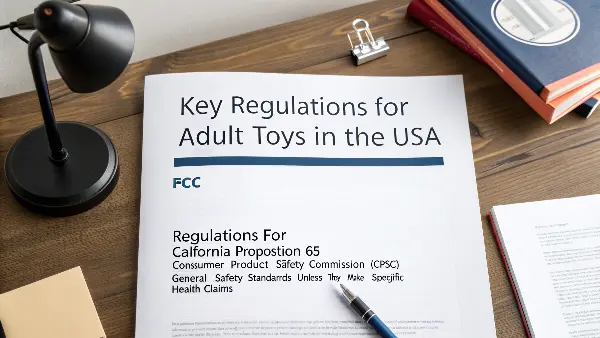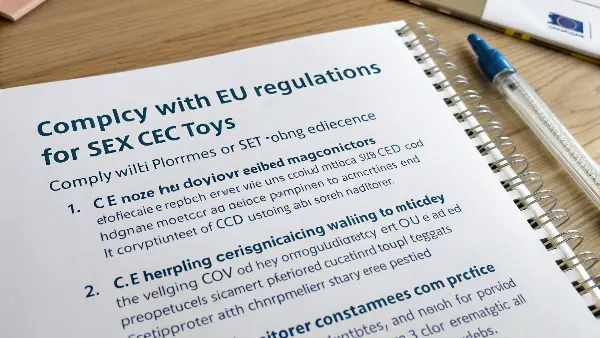You’ve perfected your product design and are ready to sell worldwide, but the complex web of international rules feels like a roadblock. A misstep in compliance could mean costly fines or blocked shipments, creating a nightmare for your brand. Understanding the core testing requirements is your key to a successful global launch.
Navigating global regulations for adult products means you must meet the specific material and electronic safety standards of your target country. Since there’s no universal "adult toy" category, products are typically classified as consumer electronics or items in contact with skin. This requires compliance with standards like CE in the EU, FCC in the USA, and UKCA in the UK, focusing on chemical safety (RoHS, REACH) and electromagnetic compatibility (EMC).

It sounds complicated, but it’s manageable when you break it down region by region. As a manufacturer who ships products globally, I’ve had to become an expert in this area to protect my clients and my business. It’s not just about ticking boxes; it’s about ensuring product safety and building a trustworthy brand. Let’s dive into the specifics for the key markets you’re likely targeting, so you can plan your launch with confidence.
What Are the Key Regulations for Adult Toys in the USA?
The U.S. is a huge market, but the patchwork of federal and state regulations can seem confusing. Get it wrong, and you could face action from consumer protection agencies, damaging your brand’s reputation. The good news is that by focusing on a few key standards, you can enter the American market with confidence and peace of mind.
In the USA, adult product compliance primarily revolves around FCC regulations for electronic devices and California Proposition 65 for chemical safety. While most adult toys are not classified as medical devices (unless they make specific health claims), they must meet the Consumer Product Safety Commission’s (CPSC) general safety standards for consumer goods. This makes material safety and proper electronic function paramount for market entry.

Navigating the U.S. regulatory landscape requires a two-pronged approach: ensuring your electronics are certified and your materials are free from harmful chemicals. From my experience working with American clients, these are the two areas that demand the most attention. Failure in either can halt your entire shipment at the border. Let’s break down exactly what you need to know.
FCC for Electronic Components
If your adult toy has any electronic function—like a motor for vibration, a remote control, or Bluetooth connectivity—it falls under the Federal Communications Commission (FCC) rules. Specifically, it must comply with FCC Part 15, which governs devices that emit radiofrequency energy. Most vibrators and smart toys are considered "unintentional radiators," meaning their primary purpose isn’t communication, but they still generate electronic noise.
Compliance usually requires testing to ensure the device doesn’t interfere with other electronic products. The process depends on the device, but it often involves a Supplier’s Declaration of Conformity (SDoC). This is a self-declaration process where the manufacturer or importer takes responsibility for the product’s compliance. You must perform the necessary tests, maintain records, and include a compliance statement in your product manual. For devices with wireless capabilities like Bluetooth, more rigorous certification might be needed.
California Proposition 65
This is one you absolutely cannot ignore, even if you sell online across the U.S. California’s Proposition 65 is a "right-to-know" law that requires businesses to warn consumers about exposure to chemicals known to cause cancer, birth defects, or other reproductive harm. The list of chemicals is over 900 and is updated regularly. Many materials used in low-cost manufacturing, like certain plastics and dyes, contain substances on this list.
| Common Chemical Group | Example Substance | Potential Use in Adult Toys |
|---|---|---|
| Phthalates | DEHP, DBP | Softening PVC plastics |
| Heavy Metals | Lead, Cadmium | Dyes, solder in electronics |
| Bisphenols | BPA | Hardening polycarbonate plastics |
To comply, you either ensure your products are free from these chemicals or place a clear warning label on your product and website for California customers. The safest route? Work with a manufacturer like us who priorities using body-safe, compliant materials like medical-grade silicone and BPA-free ABS plastic from the start.
How Do You Comply with EU Regulations for Sex Toys?
The European Union presents a massive, unified market, but its CE marking and web of directives can be intimidating for sellers. Non-compliance is not an option, as it will prevent your products from ever clearing customs and reaching your customers. Understanding the core EU directives is your passport to unlocking this lucrative market.
To sell adult toys in the European Union, your product must bear the CE mark, which signifies conformity with key EU directives. The most critical ones include the RoHS Directive, which restricts hazardous substances; the EMC Directive for electromagnetic compatibility; the Low Voltage Directive (LVD) for products within certain voltage ranges; and the REACH regulation, which governs chemical safety.

When I first started exporting to Europe, navigating the CE certification process felt like a huge task. But I quickly learned it’s a logical system designed to ensure all products sold in the EU are safe. The CE mark isn’t just a sticker; it’s a declaration from you, the brand owner, that your product meets all applicable laws. Getting this right is fundamental to building a successful brand in Europe.
The CE Marking Process
The CE mark is your product’s passport for the EU market. It’s a self-certification process where you, as the responsible party, declare that your product adheres to all relevant European directives. This involves several key steps:
- Identify Applicable Directives: Determine which EU directives apply to your specific product. For a rechargeable vibrator, this would typically include RoHS, EMC, and sometimes the LVD.
- Conduct Conformity Assessment: This means you have to test your product to ensure it meets the technical requirements of those directives. You can work with a third-party lab for this testing.
- Compile a Technical File: You must create and maintain a comprehensive technical file. This file contains all the evidence proving your product’s compliance, including design drawings, risk assessments, test reports, and component lists.
- Issue a Declaration of Conformity (DoC): This is a formal, one-page document signed by you, listing the directives your product complies with and the standards it has been tested against.
- Affix the CE Mark: Once the above steps are complete, you can legally place the CE mark on your product, packaging, and manual.
Key Directives to Know
Understanding the main directives will make the process much clearer.
| Directive/Regulation | Full Name | What It Covers |
|---|---|---|
| RoHS | Restriction of Hazardous Substances | Restricts the use of specific hazardous materials like lead, mercury, and cadmium in electrical equipment. |
| EMC | Electromagnetic Compatibility Directive | Ensures your device doesn’t interfere with other electronics and isn’t affected by interference from them. |
| LVD | Low Voltage Directive | Ensures the health and safety of consumers using electrical equipment within certain voltage limits (50-1000V AC). |
| REACH | Registration, Evaluation, Authorisation of Chemicals | Manages risks from chemicals. It requires reporting on "Substances of Very High Concern" (SVHCs) if present. |
As a manufacturer, we manage this process for our clients every day. We ensure the materials we source are RoHS and REACH compliant and that our electronic designs pass EMC testing. This integrated approach saves our clients time, money, and the stress of navigating this alone.
What About the UK Market After Brexit?
With the UK’s departure from the EU, many brand owners are confused about which rules to follow. Selling to British customers used to be covered by EU regulations, but now there’s a new system in place. Ignoring these changes could mean your products are turned away at the UK border, even if they are fully EU-compliant.
To sell adult products in Great Britain (England, Scotland, and Wales), you now need to use the UKCA (UK Conformity Assessed) mark instead of the CE mark. The UKCA mark demonstrates compliance with UK regulations, which currently mirror EU standards but may diverge in the future. You will need a UK Declaration of Conformity and must adhere to UK-specific rules for importer labeling.

The introduction of the UKCA mark created a new layer of administrative work for everyone selling into the UK. Initially, there was a lot of uncertainty, but the rules have now become clearer. The key takeaway is that you can no longer rely solely on your EU compliance to access the UK market. It requires a separate, though very similar, compliance process.
Understanding the UKCA Mark
Think of the UKCA mark as the British equivalent of the CE mark. The underlying technical requirements and the standards used to prove conformity are largely the same as their EU counterparts for now. For instance, the UK’s version of the RoHS directive is functionally identical to the EU’s. However, the legal framework is separate.
Here’s what you need to do:
- Affix the UKCA Mark: The UKCA mark must be placed on the product, packaging, or an accompanying document.
- Draft a UK Declaration of Conformity: This document is similar to the EU DoC but must list the relevant UK legislation (referred to as "designated standards") instead of EU directives.
- Appoint a UK-based Representative (if applicable): If you are based outside the UK, you may need an authorized representative located in the UK.
- Include Importer Details: If you are selling to a distributor in the UK, their name and address must be on the product or its packaging.
The Special Case of Northern Ireland
Things get a bit more complex due to the Northern Ireland Protocol. To avoid a hard border with the Republic of Ireland (an EU member), Northern Ireland continues to follow EU rules for goods.
- Selling into Northern Ireland: You must continue to use the CE mark.
- Using a UK Body for Assessment: If you use a UK-based conformity assessment body to test for CE compliance, you must also add the UKNI mark alongside the CE mark.
Essentially, for a product to be sold across the entire UK (Great Britain and Northern Ireland), it might need both the UKCA and CE markings. It’s crucial to map out your sales strategy and ensure your products carry the correct marks for each specific region you sell in.
Conclusion
Navigating global regulations for adult products in the US, EU, and UK requires a detailed, region-specific approach. By understanding the core requirements—FCC and Prop 65 in the US, CE marking in the EU, and UKCA in the UK—you can ensure a smooth, compliant entry into these major markets.
